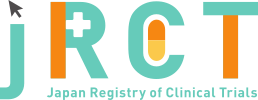臨床研究等提出・公開システム
|
Oct. 18, 2022 |
|
|
June. 26, 2024 |
|
|
jRCT1032220388 |
A Randomized phase II trial aimed to assess the usefulness of the francine needle in endobronchial ultrasound-guided transbronchial needle aspiration or biopsy |
|
Assessing the usefulness of the francine needle in EBUS-TBNA |
|
Mar. 08, 2023 |
|
12 |
|
A: Lancet - Franseen / B: Franseen - Lancet, Each group had 6 participants Age median A 73.5 years B 72.0 years p = 0.639 Sex A 5 male 1 female B 5 male1 femalep= 1.000 Body height median A 163.2cm B 162.6cm p = 0.603 Body weight median A 61.8kg B 55.5kg p = 0.401 Smoking A + 6 - 0 B + 5 - 1 p = 0.296 |
|
All 12 cases were completed bronchoscopy. Two specimens in group B were diagnosed as benignity, therefore, the outcome analysis was performed in 10 cases |
|
Bleeding 19, Hypertension 2, Pneumonia 1, Bronchoscope injury 1 Bleeding: (Franseen) Minor 10 (Lancet) Trivial 2, Minor 7 Severe adverse event was not occurred. |
|
Primary outcome: Tissue area Franseen 15.7mm2 Lancet 12.2mm2 p = 0.355 Secondary outcome: Tumor cellularity Franseen 60.0% Lancet 40.0% p = 0.608 Blood contamination rate Franseen 55.0% Lancet 45.0% p = 971 Diagnostic concordance rate 91.7% Success rate of molecular testing Franseen 6/7 (85.7%) Lancet 4/7 (57.1%) Adverse events (Bleeding): 19 cases (Franseen) Minor 10 (Lancet) Trivial 2, Minor 7 Severe adverse event was not occurred. Adverse events (Others): Hypertension 2, Pneumonia 1, Bronchoscope injury 1 Severe adverse event was not occurred. |
|
We conducted a single-center prospective study and assessed the usefulness of Franseen needle dedicated endobronchial ultrasound-guided transbronchial needle aspiration, and found that the Franseen needle tended to show a greater amount of specimen with higher tumor cellularity which may contribute higher success rate of molecular testing. |
|
Aug. 01, 2024 |
|
No |
|
None |
|
https://jrct.niph.go.jp/latest-detail/jRCT1032220388 |
Ikari Jun |
||
Chiba University Hospital |
||
1-8-1 Inohana Chuo-ku Chiba 260-8670, Japan |
||
+81-43-222-2576 |
||
junikari@chiba-u.jp |
||
Ikari Jun |
||
Chiba University Hospital |
||
1-8-1 Inohana Chuo-ku Chiba 260-8670, Japan |
||
+81-43-222-2576 |
||
junikari@chiba-u.jp |
Complete |
Oct. 18, 2022 |
||
| 12 | ||
Interventional |
||
randomized controlled trial |
||
open(masking not used) |
||
active control |
||
parallel assignment |
||
diagnostic purpose |
||
1) Patients with suspected primary lung cancer |
||
1) Patients who have a history of treatment for lung cancer |
||
| 20age old over | ||
| No limit | ||
Both |
||
Lung cancer |
||
Patients are received EBUS-TBNA or TBNB using these devices under randomised: |
||
lung cancer, |
||
Bronchoscopy |
||
D008175 |
||
D001999 |
||
Tissue area of each lymph node sample |
||
Tumor percentage of each lymph node |
||
| Clinical Research Initiation - Fund of Chiba University Hospital | |
| Not applicable |
| Chiba University Certified Clinical Research Review Board | |
| 1-8-1 Inohana, Chuo-ku, Chiba City, Chiba | |
+81-43-226-2616 |
|
| prc-jim@chiba-u.jp | |
| Approval | |
Sept. 30, 2022 |
none |
